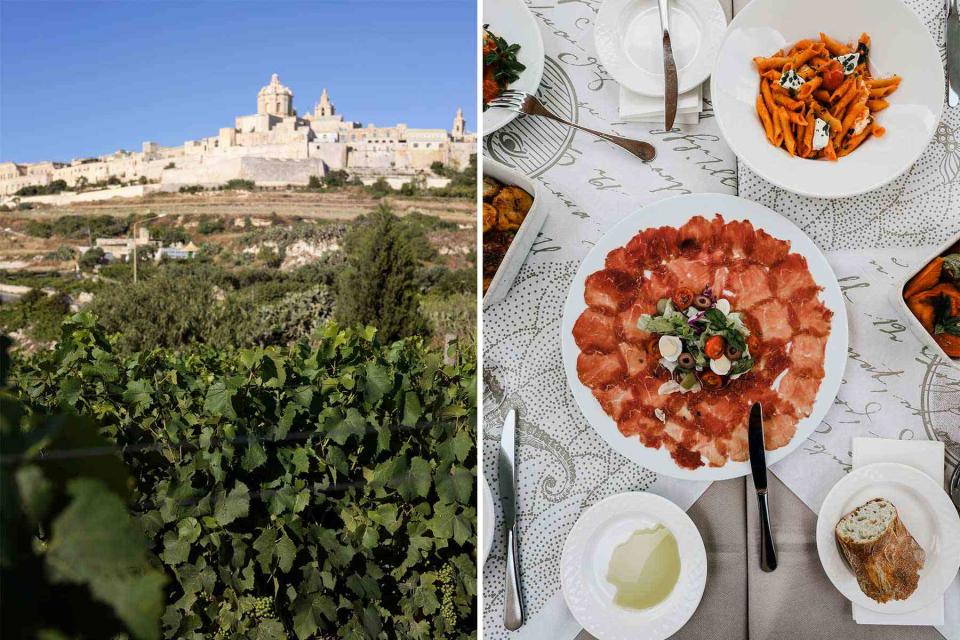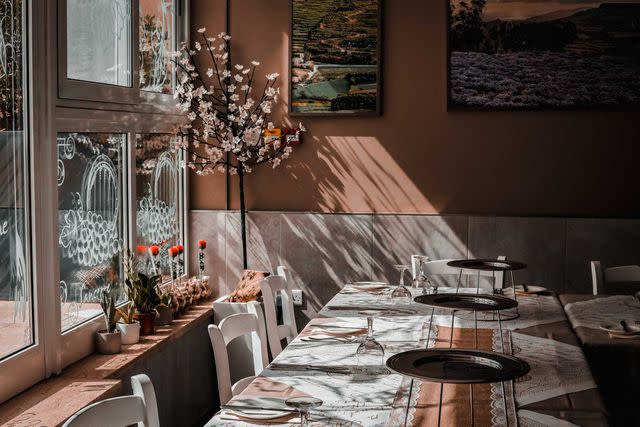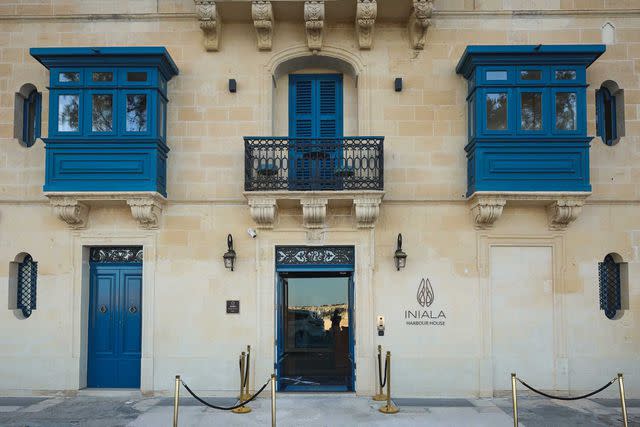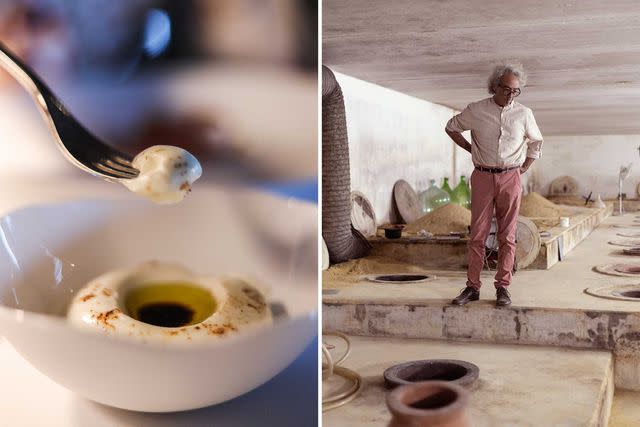This Mediterranean Island Is One of the Smallest Wine-making Countries in the World
Grapes have been cultivated in Malta for centuries, but the wines of this Mediterranean archipelago have remained relatively unknown — until now.

Ritty Tacsum
From left: One of Delicata’s partner vineyards sits just outside the walled town of Mdina, Malta; beef carpaccio and pasta at Ta’Philip.The scent of lemon trees hung in the stillness. Olive groves swept over the slopes and giant pear cacti appeared like rabbit ears above the ground. From beneath the canopy came the sound of laughter as a woman in a white dress swirled her glass and invited us to inhale. “Only smell it once!” ordered Maria Spiteri. “The more you smell, the less you can smell.” As instructed, I pinched the stem of my glass to avoid transferring body heat to the wine and then sniffed the pale vermentino, sensing the aroma of pear. With the attention of a schoolteacher, Spiteri paced around tables, explaining how visitors should relish their wine — under the tongue, with deep breaths, and absolutely no gulping.
Spiteri recently took over the wine estate Ta’Mena, on Gozo, the second-largest island in the Maltese archipelago. Her grandparents, Mena and Francis, began growing fruit and vegetables on this land in the 1960s; in 2002, the family bought up acres of groves and vineyards and expanded into making olive oil and wine.

Ritty Tacsum
An estate-made liqueur being bottled at Ta’Mena.Mena’s original farm shop is still there, run now by Spiteri’s mother, Marnese, who sells bitter-orange marmalade, jars of marinating cheese, and kunserva helwa — a dark, sweet concentrate of sun-dried tomatoes. Visitors can also find the farm’s produce on the tables of Ta’Philip, a restaurant in the village of Ghajnsielem, also on Gozo. Run by Spiteri’s uncle Philip, the restaurant specializes in meats cooked overnight in a wood-burning oven.
At just 122 square miles, Malta is one of the world’s smallest wine-making countries, with little more than 1,000 acres available for viticulture. Yet, it produces an incredible range of wines, including merlot, cabernet sauvignon, syrah, and chardonnay, as well as two indigenous grape varieties: ?ellew?a (a red) and Girgentina (a white). And despite a history of wine making reportedly dating back to around 700 B.C., only in recent years has the country’s industry taken off, as small, family-run vineyards like the Spiteris’ began to offer tours and cooking classes.
After my introduction at Ta’Mena, I was curious to know more, so I hopped over to the larger island of Malta for a broader lesson. I began at Delicata, in the town of Paola, just across the grand harbor from the capital, Valletta. When I entered the winery, set right on the water, I found a 300-year-old winding staircase leading up to the austere vault. There I met Georges Meekers — a Belgian wine writer and Delicata’s marketing director — who had six bottles decanted and awaiting my arrival.

Ritty Tacsum
The dining room at Ta'Philip, on the island of Gozo.We began with the ?ellew?a (pronounced jah-low-za) frizzante, a fresh, semi-sparkling wine the color of apricots. Meekers explained that no one knows for sure where these native varieties originated, who planted them, or where their names came from. “It’s been suggested that Girgentina relates to the village of Girgenti in south Malta,” he said. “?ellew?a probably comes from the Arabic word for hazelnut.”
Malta is home to 20 varieties of grapes — Delicata itself produces 30 different labels — but Maltese wine is not widely available abroad. “Nearly everything Malta produces is consumed locally, so there’s no need to export,” Meekers told me.
Unusually, Delicata doesn’t own a single vineyard: starting in 1994, the family that owns it invited anybody with a piece of land to start growing grapes, encouraging the planting of both international and native varieties. What began as a handful of people swelled to more than 200 farmers. “Delicata does the research for them,” Meekers said. “The winery’s viticulturists take soil samples and tell them which varieties are suitable for their land. We give them start-up capital and guarantee that we are going to buy their grapes if they are up to standard.”

Ritty Tacsum
The hotel Iniala Harbour House is set in four town houses in Vallettaa??s center.Two hours and six wines later, I wobbled out of the cool vault and made my way to an early dinner at Ion Harbour, the rooftop restaurant at Iniala Harbour House. I had a panoramic view of the cliffs that surround Valletta’s harbor, and the limestone had begun to turn gold in the evening light. A chef named Alex Dilling had taken over the kitchen, and having enjoyed his fine-dining approach at the Greenhouse in London, I wanted to see what he was creating in Valletta. Over curls of marinated pink shrimp and line-caught lampuki — a native mahi-mahi — I sipped a local chardonnay, nudging away the 40-page menu of foreign wines. The dishes felt playful, from the foie gras shaped like shiny black billiard balls to the gold-leaf dust, beads of caviar, and jellies.
The next day, I drove across Malta to the town of Si??iewi to meet Mark Cassar at his vineyard, Marcasar. I entered a room that seemed part scientist’s lab, part man cave: the tables were crowded with hundreds of glasses, bottled olives, unopened boxes, and piles of crockery. Cassar, who wore tortoiseshell glasses and carried a pipe, poured out an amber liquid that resembled beer, smelled like cider, and tasted of smoke. “It’s a chardonnay that has been macerated for three months with the skins and pips,” he explained.

Ritty Tacsum
From left: ?bejna, a traditional Maltese cheese, served at Ion Harbour; Mark Cassar with earthenware pots he uses to ferment his wines.Our one-on-one tasting included platters of cheese and cold cuts and, rather dangerously, had no limit on wine consumption for up to four hours. During that time, we chatted about Cassar’s Greek grandmother’s alcohol-rich trifles and his penchant for wine as a child. He showed me how he ferments his wines in Georgian qvevri (earthenware pots) and revealed that his best-selling natural wine, Sacrum, is made with hemp — which he keeps stacked like hay in a room.
After I left Cassar, I drove back across the island, passing mile after mile of vineyards. I wondered whose tables the bottles would eventually reach.
A version of this story first appeared in the September 2022 issue of Travel + Leisure under the headline "Bearing Fruit."
